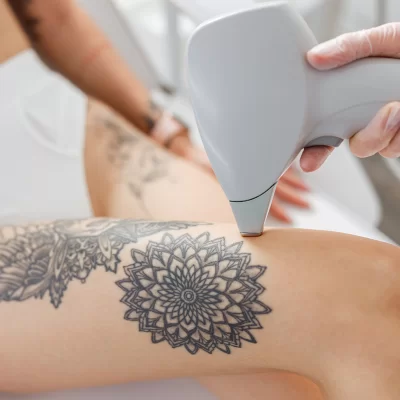Depilacja laserowa a tatuaż
Laser hair removal near a tattoo requires careful attention. The laser used for hair removal during this procedure can affect the pigments in the tattoo. Although the laser energy is mainly absorbed by the melanin in the hair, the impact on the tattoo pigments should not be overlooked.
Tattoos can pose challenges for laser hair removal, but it doesn't mean you have to avoid these treatments. The key is proper preparation and protection of the tattooed area before starting the procedure, significantly reducing the risk of potential skin damage.
If you are considering laser hair removal near or directly on a tattoo, consult with a specialist. The expert will assess the condition of your skin and advise on the optimal and safe way to perform the treatment, ensuring the safety of both your skin and the tattoo.
A tattoo is not an absolute contraindication for laser hair removal, but its presence requires special caution during the procedure. The greatest risk is directing the laser directly onto the tattoo, which can lead to burns and damage to both the skin and the tattoo design. Therefore, during the treatment, areas with tattoos should be avoided or special protective shields should be used.
Laser hair removal involves the absorption of energy by the melanin in the hair, which can also affect the pigments in the tattoo. This can result in fading of the color or even complete disappearance of the tattoo design in the areas exposed to the laser. Excessive exposure to laser energy during treatments can cause side effects such as skin redness or blistering.
For large tattoos located in areas undergoing hair removal, avoiding these areas becomes necessary. It is also important to consult with an experienced specialist before starting the treatment. The professional will assess the condition of the skin and advise on how to perform laser hair removal without harming the tattoo.
Remember also about other contraindications to laser hair removal such as chronic diseases, sunburn, or skin infections. Avoid such procedures during pregnancy and breastfeeding, and inform the specialist about any medications and herbal supplements you are taking.
Laser hair removal can affect tattoos, as the laser light is absorbed by pigments in the skin. While the energy typically targets the melanin in hair, it can also impact tattoo pigments. This can lead to changes in the appearance of the tattoo, such as fading or distortion of the design. This occurs because the tattoo pigments react to the laser in a similar way as melanin. The risk of damaging the tattoo design arises mainly when the laser beam directly hits the tattooed area.
Laser hair removal on tattooed skin carries some risks. Firstly, there is a possibility of lightening or changing the color of the tattoo itself. Tattoo pigments absorb the laser energy, sometimes leading to partial disappearance of the design.
In addition, irritations and burns may occur on the tattooed skin. The laser increases the skin's sensitivity, making it more susceptible to damage or infections. Scabs that form after the treatment can come off, destroying the tattoo and creating gaps.
Especially at risk are tanned skin or skin with darker tattoos. Dark pigment absorbs laser energy more intensely, increasing the risk of redness or blisters.
To reduce the risks associated with laser hair removal, it is advisable to avoid directing the laser directly onto tattooed areas and to use special protective covers during depilation.
Check out the differences between laser hair removal and epilation.
Protecting your tattoo during laser hair removal is crucial to avoid damage to both the skin and the tattoo itself. There are several effective ways to protect a tattoo from the effects of laser treatment:
- Using white chalk to effectively reflect the laser beams, reducing their impact on the tattoo pigments,
- Applying special protective creams that create a barrier on the skin, protecting it from direct contact with the laser,
- Covering the tattoo with a bandage or special dressing to physically block the laser's access to the pigment in the skin.
Properly securing the skin allows hair removal around the tattoo without risking damage to it. A specialist will help choose the safest protection method to preserve the tattoo's longevity and maintain healthy skin after laser hair removal.
Laser rays used during hair removal can affect tattoos because they are absorbed by the ink pigments. This can lead to lightening or changing the color of the design. Lasers interact with tattoo pigments similarly to melanin in hair, increasing the risk of damaging the artwork. Changes in the appearance of the tattoo can be irreversible, so protecting it during the procedure is extremely important.
Laser hair removal on areas adjacent to a tattoo increases the risk of discoloration and blurring of the design contours. It is crucial to use protective measures that limit the laser's contact with tattoo pigments. Before undergoing laser hair removal near a tattoo, it is advisable to consult with a specialist who can help choose the appropriate protection method and avoid adverse changes in the tattoo's appearance.
After laser hair removal, the skin becomes more susceptible to irritation and infections, which can negatively impact the tattoo's aesthetics. Additionally, scabs formed after the procedure can damage the design by peeling off pigment fragments.
To maintain the tattoo's intact appearance, it is important to avoid directing the laser directly onto the tattooed areas. This way, you can effectively protect both the skin and the tattoo.
